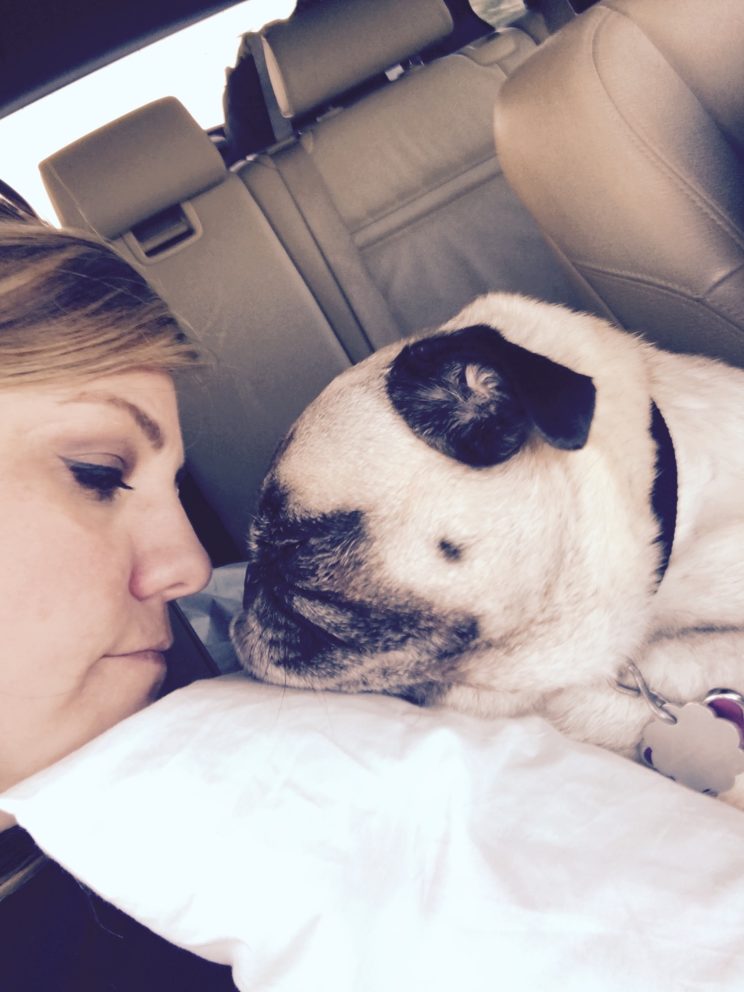
Austin Animal Center (AAC) recently killed Tucker, a dog, who had three places to go: a local non-profit organization; a trainer/rescuer out of state; and Tucker’s former family who pleaded with them to release him to their care. The official justification for his killing is “behavior” or “aggression.” Tucker had a bite history. The real cause of death appears to be spite. This is the story of his short life and tragic death.
Beginning

It is not uncommon for Tawanna Verock or her colleagues to come across dogs left behind by others. She works in real estate. It is a “hazard” of the trade, she tells me. People come and go; move in and move out. Sometimes dogs get left behind. So when Tucker was found as a young puppy left abandoned on a property by one of her colleagues, Tawanna took the little dog in. He fit right in with her family, which included a cat and three other dogs.

Tawanna vetted him, neutered him, crate-trained him, and loved him. Tucker, she said, was a “great little dog.” He had no aggressive behavior issues “whatsoever.” He did, however, have one bad habit given the large tree in her yard that abutted her fence: he could climb. After he discovered that by climbing the tree, he could get over the fence, Tucker freely explored the neighborhood. “He had a lot of energy,” she told me. An amputee, Tawanna could not keep up with him and she would get “tuckered” out retrieving him. It earned him his name.
Betrayed

Tawanna found Tucker a home with a local person, an active runner, who not only promised to run with Tucker, but would bring him to work. She also did not have any trees in her backyard. It seemed like a perfect match: an active family for an active dog with lots of attention.
Sadly, it is also one of the “hazards” of rescue work that sometimes what seems like a perfect match isn’t one after all. Tucker’s new home fell apart when his new owner separated and moved Tucker into an unstable environment with people, Tawanna later learned, who taunted him. Internal AAC records which shelter management provided to Tawanna show Tucker was not treated well. “That’s when he started acting out,” Tawanna said.
In one incident, AAC notes that “the roommate was drunk and trying to ‘dominate’ Tucker and put her foot in his face;” which may have been a euphemism for kicking him. Tucker bit her foot. Rather than return him to her, Tucker was ultimately surrendered to AAC. Tawanna only learned of Tucker’s pending fate, and his unstable home, when someone told her Tucker was the subject of a very public battle to save him. AAC had announced that Tucker was to be killed because of his bite history. Final Frontier Rescue Project — a non-profit organization that specializes in dogs facing death because of bite histories — offered Tucker placement.
AAC said No. FFRP is run by a No Kill advocate loathed by the management of the City shelter for her outspokenness against killing dogs for behavior reasons, for calling them out on their violations of department protocols related to behavior dogs, and for failing to develop more progressive policies. Regardless of how they felt about its founder, Final Frontier Rescue Project had a good track record of saving and placing dogs AAC scheduled to be killed. “Final Frontier kept all dogs in their care safe and people safe,” said a former AAC official. “They do not have a track record of putting people at risk.” Another AAC insider told me that “regardless of how they feel about [the founder], there was no good reason to deny the request.”
When AAC said “no,” a spokesman for FFRP offered to take Tucker out of state to get the training he needed and appropriate placement, never to return. AAC again refused.
Refused

Tawanna was at the airport in Austin picking up her daughter when she was forwarded a Facebook post by FFRP about Tucker. She reached out to FFRP, learned more about Tucker’s scheduled killing, and then, instead of coming home, went straight to the shelter.
She told the staff that she was Tucker’s former owner, and she was willing to take him home and pay any fees that were due. They told her that no one who had authority to make a decision was available to speak to her and to call back the next day. After several attempts to speak to an AAC manager by telephone the following day, repeatedly met by the voice mailbox, she drove to the shelter. She came armed with photographs of Tucker in her home and his veterinary records from his time with her.
But AAC managers would not allow her to see Tucker. They would not let her demonstrate how well Tucker behaved with her and her family, which would show that Tucker was not the hopelessly aggressive dog they claimed he was.
Instead, AAC managers tried to dissuade her, tried, she says, to “legally intimidate her” by telling her that Tucker was aggressive and she would be held liable if something went wrong. That’s not the Tucker I know, she told them. It was also not the dog some of the ACC dog walkers knew. The records they handed her included testimonials by AAC volunteers who said Tucker was a nice, friendly dog. That was the Tucker she knew. But the documents she was handed also documented Tucker’s abuse. To be sure, there were also records of bites. And a few of the dog walkers noted growling and snapping related to food and being returned to his kennel; specific triggers solvable with training. According to those notes, he seemed to respond well when they were addressed. Tawanna told AAC she would get Tucker whatever further training they felt he needed.
“Whatever I can and need to do, I will do,” she told them. In addition to training, she offered to provide an umbrella and liability insurance policy. She offered to keep him away from everyone but her family and her family of dogs, who Tucker once lived with and played with. “Just let me have Tucker.”
They refused.
Tawanna says she appealed to Kimberly McNeeley, Austin’s Interim Chief Animal Services Officer. She got nowhere. Kimberly, she said, appeared to be reading from a script. “There was no real communication with her,” she told me. “I was begging her, pleading with her.” I told her “the dog you describe on paper is not Tucker.” Again, she promised training, insurance, and keeping him in her home.
According to an Austin source who requested anonymity for fear of reprisal, AAC “was set on killing the dog” even if it meant violating standard practices and their own protocol to do so. AAC policy allows the return of dogs to former owners, even if those dogs are declared “dangerous” by a court because of a serious bite history. Tucker was neither the subject of any court hearing, nor been declared dangerous. Under policy, returning Tucker to his former owner, especially one who offered any course of action deemed necessary by AAC, was permissible. Along with conditions to protect public safety, not wanting to take Tucker’s one and only life, or further the emotional anguish of a tax-paying, Good Samaritan Austinite, should have been dispositive.
Indeed, until she was removed from her position several years ago after the City Council approved a No Kill initiative, Dorinda Pulliam was the notorious Austin pound director who killed over 100,000 animals during her tenure, who refused to vaccinate community cats or treat them when they were sick, allowing them to suffer horribly in the pound. She opposed a public foster care program, choosing to kill underaged animals instead. She killed for convenience despite hundreds of empty cages. She claimed only 35% of animals were adoptable and the rest should be killed. And she once told a reporter that she did not like when advocates paid for adoption ads because too many people would call the shelter looking to adopt and she did not want her staff spending the time talking to them. And yet, “Even Dorinda Pulliam would have returned Tucker,” says the Austin insider. Why wouldn’t Kimberly McNeeley?
Retribution

AAC says that they did not return Tucker because Tawanna did not have an adequate plan for him, but another Austin official tells me that is “complete bullshit. It is the shelter’s job to come up with the plan.” And, the official says, they have returned dogs to former owners even without one. Moreover, Tawanna did have a plan: keeping him at home, watching him at all times (she now works from home), training, and insurance. She also offered to do anything and everything AAC asked of her to ensure public safety.
Why then did AAC refuse?
According to two Austin insiders familiar with the case, it was because they thought that Tawanna would transfer the dog to Final Frontier Rescue Project and they do not like the founder.
Spite.
Worse than spite, if true, this refusal would constitute retaliation for FFRP’s founder exercising her First Amendment rights to free speech and to petition her government for a redress of grievances, a violation of Federal law. Even if Tawanna intended to turn the dog over to FFRP, AAC should have given her the dog. In fact, they should have turned Tucker over to FFRP before the former owner even became involved. Doing so would not only have been within well-established precedent, but consistent with the mandate approved by the Austin Animal Advisory Commission, which approved a bill in 2018 to make it illegal for AAC to kill animals if qualified rescue groups offered to save them. Unfortunately, that bill never became law. Once a bill is approved by the Commission, it is supposed to be referred to the City Council, with appropriate follow up to ensure it gets a sponsor and is put on the Council’s agenda for consideration and vote. But, said a former Commissioner, “No one ever followed through.”
Had the rescue rights bill been enacted into law, Tucker would still be alive today. Moreover, the law would have had other benefits, including leveling the playing field among the groups working to protect Austin animals. Had Austin Pets Alive requested Tucker, for example, AAC would have approved the transfer. As a non-profit, rescue organization recognized under Section 501(c)(3) of the Internal Revenue Code, FFRP is legally equal to Austin Pets Alive and should be treated no differently.
Second, it would have spared individuals emotional anguish from being denied the opportunity to save animals. Rescuers are already donating their time, their energy, and their resources to make the world a better place for animals. They shouldn’t have to sacrifice their emotional well-being, too.
Third, it would have created a whistleblower provision allowing rescuers, like the founder of FFRP, to exercise their First Amendment rights without fear of reprisal from shelter managers.
Fourth, foremost, and finally, it would have saved animals.
In 2018, under prior leadership, AAC killed only five dogs all year for behavior, roughly one out of every 1,000 dogs. In the first 5 ½ months of 2019, AAC’s new leadership has killed 17 dogs for behavior, including three last Friday. Like Tucker, FFRP offered to take two of the three if AAC could hold them until placement could be arranged. Kimberly McNeeley, AAC’s interim chief, declined. FFRP only found out about the third, a dog named Poseidon, after he was killed. A notice of intent to kill Poseidon was not publicly made as AAC managers did not intend to allow rescue placement.
Gone
On June 4, the day Tucker was scheduled to be killed, Tawanna drove to the shelter to speak to Kimberly. Kimberly refused to see her. Another AAC employee came out and told her she had no rights to the dog and demanded that she leave the building. She left, “dejected.”
At 3:30 pm, the appointed time set for his execution, Tucker was delivered to a veterinarian who administered a fatal dose of poison. “They followed through with it,” she tells me, sobbing uncontrollably through the phone. Tucker was “gone.”
She wants to say something else, but she is gasping for breath. I wait. Finally, it comes.
“He was a really good dog.”
The phone goes silent, except for the sound of her crying.
————-
Have a comment? Join the discussion by clicking here.